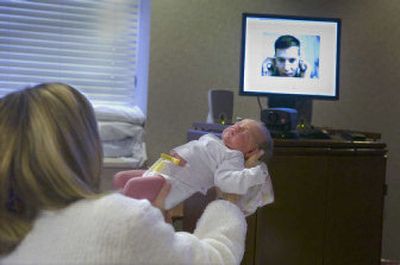Webcam lets dad in Iraq meet newborn daughter

Someday, Seville Maria Stoll might marvel at the technology that allowed her to meet her father from 6,800 miles away.
Then again, maybe not.
By the time the tiny girl born Wednesday at Deaconess Medical Center grows up, it might be commonplace to link far-flung soldiers with new family members back home.
But on Thursday, there was still something magic about the tools that allowed Maj. Kevin Stoll of the U.S. Army Corps of Engineers to count his daughter’s toes from Iraq.
Even with several dropped signals and transmission delays, there was no mistaking the new dad’s emotion.
“She’s beautiful!” said a smiling Stoll, 33, as he peered at a video image beamed through a hospital room camera.
Back in Spokane, new mom Jennifer Stoll, 32, hoisted the 6-pound, 14 1/2-ounce bundle aloft, carefully giving her husband a full view.
“Can you see her good?” said Jennifer, who delivered the baby by Caesarean section. “Can you see her feet?”
“I think she’s got your nose; it’s hard to tell,” responded Kevin, whose image filled a 20-inch computer screen propped on a corner table. On the bed next to his mother, the couple’s 2-year-old son, Solden, wore a T-shirt that read “I’m the big brother!” as he completed the family tableau.
It was a scene composed courtesy of the technology staff at Deaconess, who agreed to rig up a virtual meeting at the request of the Stoll family.
Kevin Stoll left for Iraq in July for a six-month tour as an engineer working with contractors building a health clinic in the Babil province. Though he’s expected back in January, he knew he’d miss the birth of the couple’s second child.
The family was stationed in Stuttgart, Germany, but Jennifer Stoll decided to return to the Medical Lake home of her parents, Joann and Ken Dibble, during her pregnancy.
Throughout Kevin’s absence, they’ve kept in touch through twice-weekly visits on the family’s home webcam. When it came time to deliver the baby, the Stolls wondered whether it would be possible to share the experience at the hospital.
Enter Charles Peterson, a desktop support analyst at Deaconess. Using a video conferencing camera, the Skype Internet network and a $50 converter, Peterson created a link between Spokane and Iraq.
“I knew if they had a standard Internet connection, a webcam and a computer, we could set up something,” said Peterson. “The biggest chink in the armor was getting hooked up on time and equipment.”
A practice session Wednesday night worked fine. That’s when Kevin got his first glimpse of his new daughter. But on Thursday, in front of a room full of reporters and television cameras, the signal was spotty and communication was delayed.
But to the new parents, it didn’t matter.
“Even with the dropped calls, it’s way better than anything,” said Jennifer.
Back in Iraq, her husband agreed.
“It’s been fantastic,” he said. “I’m glad we’re able to do it. Pictures don’t tell half the story.”
The webcam at home and the video conference in the hospital have allowed Kevin to remain a daily presence in his family’s life, his wife said.
“If it’s one more thing that they have to comfort them while they’re in a place of hardship, it’s good, you know,” said Jennifer. “You would like them to know everything about their baby right away.”
Deaconess officials are considering expanding such video services, said spokeswoman Christine Varela. They’ve made similar arrangements in rare instances before, but not involving military families.
“We have a lot of Air Force wives and girlfriends who have their babies here,” she said. “It’s such a special and monumental occasion.”
Expanding technology long has been viewed as a bridge between separated loved ones, said Tom Bivins, a professor of media ethics at the University of Oregon in Eugene. From the telegraph and the telephone to cell phones and satellites, the tools offer at least an approximation of connection.
“I certainly think that it is better in some ways to have even a virtual presence at a time like this than no presence at all,” Bivins said.
But, he added: “Does this connection really connect, or does it leave us ultimately more desperate for the ‘real’ thing?”
For Kevin Stoll, there was no question. A video glimpse of his little girl is good, but he knows what he’ll do when he gets off the plane in January.
“I’m going to grab all three of them in my arms,” he said, “and hold them for as long as I can.”